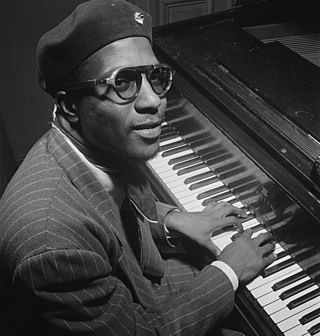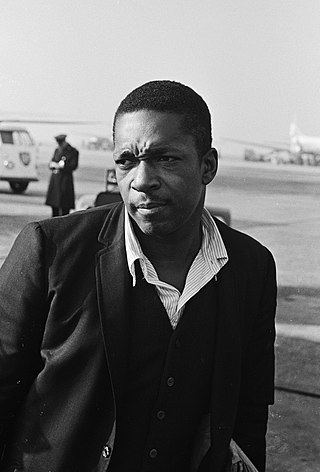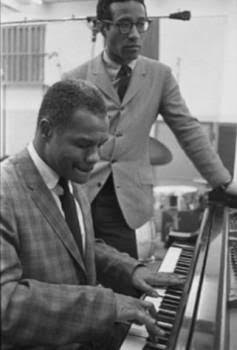
Bebop or bop is a style of jazz developed in the early-to-mid-1940s in the United States. The style features compositions characterized by a fast tempo, complex chord progressions with rapid chord changes and numerous changes of key, instrumental virtuosity, and improvisation based on a combination of harmonic structure, the use of scales and occasional references to the melody.

John William Coltrane was an American jazz saxophonist, bandleader and composer. He is among the most influential and acclaimed figures in the history of jazz and 20th-century music.
Modal jazz is jazz that makes use of musical modes, often modulating among them to accompany the chords instead of relying on one tonal center used across the piece. Although precedents exist, modal jazz was crystallized as a theory by composer George Russell in his 1953 book Lydian Chromatic Concept of Tonal Organization.

Thelonious Sphere Monk was an American jazz pianist and composer. He had a unique improvisational style and made numerous contributions to the standard jazz repertoire, including "'Round Midnight", "Blue Monk", "Straight, No Chaser", "Ruby, My Dear", "In Walked Bud", and "Well, You Needn't". Monk is the second-most-recorded jazz composer after Duke Ellington.

Arthur S. Taylor Jr. was an American jazz drummer, who "helped define the sound of modern jazz drumming".
Coltrane changes are a harmonic progression variation using substitute chords over common jazz chord progressions. These substitution patterns were first demonstrated by jazz musician John Coltrane on the albums Bags & Trane and Cannonball Adderley Quintet in Chicago. Coltrane continued his explorations on the 1960 album Giant Steps and expanded on the substitution cycle in his compositions "Giant Steps" and "Countdown", the latter of which is a reharmonized version of Eddie Vinson's "Tune Up". The Coltrane changes are a standard advanced harmonic substitution used in jazz improvisation.

Jazz piano is a collective term for the techniques pianists use when playing jazz. The piano has been an integral part of the jazz idiom since its inception, in both solo and ensemble settings. Its role is multifaceted due largely to the instrument's combined melodic and harmonic capabilities. For this reason it is an important tool of jazz musicians and composers for teaching and learning jazz theory and set arrangement, regardless of their main instrument. By extension the phrase 'jazz piano' can refer to similar techniques on any keyboard instrument.

Interstellar Space is a studio album by American jazz saxophonist John Coltrane, featuring drummer Rashied Ali. It was recorded in 1967, the year of his death, and released by Impulse! Records in September 1974.

Thelonious Monk with John Coltrane is a 1961 album by Thelonious Monk issued on Jazzland Records, a subsidiary of Riverside Records. It consists of material recorded four years earlier when Monk worked extensively with John Coltrane, issued after Coltrane had become a leader and jazz star in his own right.

Africa/Brass is the eighth studio album by jazz musician John Coltrane, released on September 1, 1961 on Impulse! Records. The sixth release by the fledgling label and Coltrane's first for Impulse!, it features Coltrane's working quartet augmented by a larger ensemble to bring the total number of participating musicians to 21. Its big band sound, with the unusual instrumentation of French horns and euphonium, presented music very different from anything that had been associated with Coltrane to date. While critics originally gave it poor ratings, more recent jazz commentators have described it as "amazing" and as a "key work in understanding the path that John Coltrane's music took in its final phases."

Soultrane is the fourth studio album by jazz musician John Coltrane, released in 1958 on Prestige Records, catalogue 7142. It was recorded at the studio of Rudy Van Gelder in Hackensack, New Jersey, three days after a Columbia Records session for Miles Davis and the Milestones album.

This article presents the discography of the American jazz saxophonist and bandleader John Coltrane (1926–1967).

Coltrane is an album by jazz musician John Coltrane which was released in October 1957 by Prestige Records. The recordings took place at the studio of Rudy Van Gelder in Hackensack, New Jersey, and document Coltrane's first session as a leader. It has been reissued at times under the title of The First Trane!.

Settin' the Pace is an album by jazz musician John Coltrane, released in December 1961 by the Prestige label. It is assembled from previously unissued tracks from a recording session at the studio of Rudy Van Gelder in Hackensack, New Jersey in 1958. Coltrane on tenor saxophone is accompanied by Red Garland on piano, Paul Chambers on bass, and Art Taylor on drums. With Garland and Chambers, Coltrane had played together since at least October 1955 in Miles Davis' band. With Art Taylor they were part of the Tenor Conclave recordings in September 1956. As a quartet they had already recorded two albums for Prestige, John Coltrane with the Red Garland Trio and Soultrane. The material the quartet recorded on this session were extended interpretations of three popular songs and "Little Melonae", a classic bebop tune written by Jackie McLean. Of note is Coltrane's use of the sheets of sound technique, particularly on "Little Melonae".

Coltrane "Live" at the Village Vanguard is a live album by jazz musician John Coltrane, released in February 1962 on Impulse Records. It is the first album to feature the members of the classic quartet of Coltrane with McCoy Tyner, Jimmy Garrison, and Elvin Jones, as well as the first Coltrane live album to be issued. In contrast to his previous album for Impulse!, this one generated much turmoil among both critics and audience alike with its challenging music.

Live at the Half Note: One Down, One Up is a 2005 double CD compilation of two previously unreleased 1965 Friday radio broadcasts – March 26 and May 7 – at the Half Note Club in New York City, featuring John Coltrane with McCoy Tyner, Jimmy Garrison, and Elvin Jones.

1958 Miles is a compilation album by American jazz musician Miles Davis, released in 1974 on CBS/Sony. Recording sessions for tracks that appear on the album took place on May 26, 1958, at Columbia's 30th Street Studio and September 9, 1958, at the Plaza Hotel in New York City. 1958 Miles consists of three songs featured on side two of the LP album Jazz Track, which was released in November 1959, one song from the same session not appearing in the album, and three recordings from Davis' live performance at the Plaza Hotel with his ensemble sextet. The recording date at 30th Street Studio served as the first documented session to feature pianist Bill Evans performing in Davis' group.

Hasaan Ibn Ali was an American jazz pianist and composer.

Dear Old Stockholm is a compilation album by jazz musician John Coltrane released by GRP and Impulse! in 1993. The music, which was recorded on April 29, 1963 and May 26, 1965 at Van Gelder Studio in Englewood Cliffs, NJ, features Coltrane's quartet with Roy Haynes substituting for Elvin Jones on drums.















